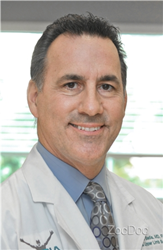
Dr. Alejandro Badia
This procedure is complex and highly technical, requiring skill and experience. But switching the ball and socket can create a more stable joint with a fixed fulcrum in patients with severe shoulder damage, particularly damage involving the rotator cuff.
MIAMI (PRWEB)
January 08, 2020
When it comes to shoulder repair, some surgeons are defying nature and doing it all backwards – and studies are showing that can be a good thing, says noted sports medicine and orthopedic specialist Alejandro Badia MD, an expert in treatment of musculoskeletal disorders of the upper limbs. He is referring to reverse shoulder replacement, also called reverse shoulder arthroplasty, in which artificial parts are used to change the natural anatomy of the shoulder’s ball-and-socket joint – the glenohumeral joint — by turning the ball at the top of the humerus (arm bone) into a socket and making the socket on the shoulder blade a ball.
“This procedure is complex and highly technical, requiring skill and experience. But switching the ball and socket can create a more stable joint with a fixed fulcrum in patients with severe shoulder damage, particularly damage involving the rotator cuff,” says Dr. Badia, founder and chief medical officer of the Florida-based Badia Hand to Shoulder Center and OrthoNOW®.
That’s because the rotator cuff, a group of muscles and tendons, is what normally powers the shoulder joint, allowing it to move and function properly. The rotator cuff keeps the ball of the arm bone centered on the shoulder-blade socket during joint rotation, including raising the arm. If the rotator cuff is too extensively torn, its tendons pulled from the bone, then a standard shoulder replacement, which maintains the shoulder’s natural ball-and-socket anatomy but requires an intact rotator cuff, will not prove effective in restoring regular shoulder function, Dr. Badia explains.
“Instead of relying on a damaged rotator cuff, a reverse shoulder replacement makes joint movement dependent on the deltoid muscle, a large, triangular-shaped muscle located on top of the shoulder and the uppermost part of the arm,” says Dr. Badia, who has years of experience in performing reverse shoulder replacements.
Most commonly, a reverse shoulder replacement is recommended for patients with significant pain due to extensive shoulder-joint osteoarthritis, with bone loss and missing or badly torn rotator cuff tendons, or for those whose quality of life is seriously impacted because a damaged rotator cuff prevents them from lifting their arm high enough for good functioning.
A complex upper arm bone fracture that involves damage to the shoulder-joint ball, chronic shoulder-joint dislocation, and a failed previous shoulder replacement also may necessitate a reverse replacement procedure, Dr. Badia says.
Although less frequently performed than hip or knee replacement surgery, shoulder replacement procedures in general have been increasing. Data from the Agency for Healthcare Research and Quality indicate more than 50,000 patients undergo shoulder replacement annually in the United States. Of these surgeries, as many as half are now reverse shoulder replacements, even though the procedure was only approved for use by the federal Food and Drug Administration about 15 years ago.
Because of the relative “newness” of reverse shoulder replacement, research to determine long-term outcomes of the procedure as it is performed in the U.S. remains scant. However, Dr. Badia indicates that studies in Europe, where the surgery has been done since the 1980s, underscore the procedure’s success in providing pain relief to as many as 90 percent of patients, restoring range of motion to the shoulder, and maintaining joint stability, with the prostheses – artificial parts used for reverse shoulder replacement – lasting up to 15 years.
In the U.S., a one-year follow-up of more than 200 patients who had undergone reverse shoulder replacement in 2017 at an average age of 70 showed “improvement in overall shoulder pain, function, and satisfaction,” according to the Cleveland Clinic’s Orthopaedic and Rheumatologic Institute.
Similar findings were reported in a study of “younger” and “more active” patients – those under age 60 – who had undergone reverse shoulder replacement due to massive, irreparable rotator cuffs and were followed up eight years or more after surgery. In that research, published in 2017 in The Journal of Bone & Joint Surgery, authors contend that the majority experienced “substantial and lasting improvement” in shoulder movement and strength and overall pain relief.
This same study found the rate of complications to be somewhat high — 39 percent. Complications can include loosening of prosthetic implants, instability of the reversed shoulder joint, persistent pain, nerve damage, bone fracture around the implant or overstressed deltoid muscle.
But Dr. Badia contends that ongoing advancements in prosthesis design, such as implants with shorter stems for the arm bone, and continuing improvements in surgical approaches are significantly reducing frequency of complications.
“That’s why it is so critical patients in need of shoulder repair and potential joint replacement consult highly experienced orthopedic surgeons who can properly diagnose their problem and offer them the best treatment options with minimal risk,” Dr. Badia concludes.
Alejandro Badia, MD, FACS, internationally renowned hand and upper-limb surgeon and founder of Badia Hand to Shoulder Center and OrthoNOW®, a walk-in orthopedic care clinic. He is a member of the American Society for Surgery of the Hand, American Association for Hand Surgery and the American Academy of Orthopedic Surgeons and an honorary member of many international professional hand societies. Dr. Badia specializes in treating all problems related to the hand and upper extremities, including trauma, sports injury, joint reconstruction, nerve injuries and arthroscopic surgeries. Go to OrthoNOWcare.com and drbadia.com.
Share article on social media or email:

